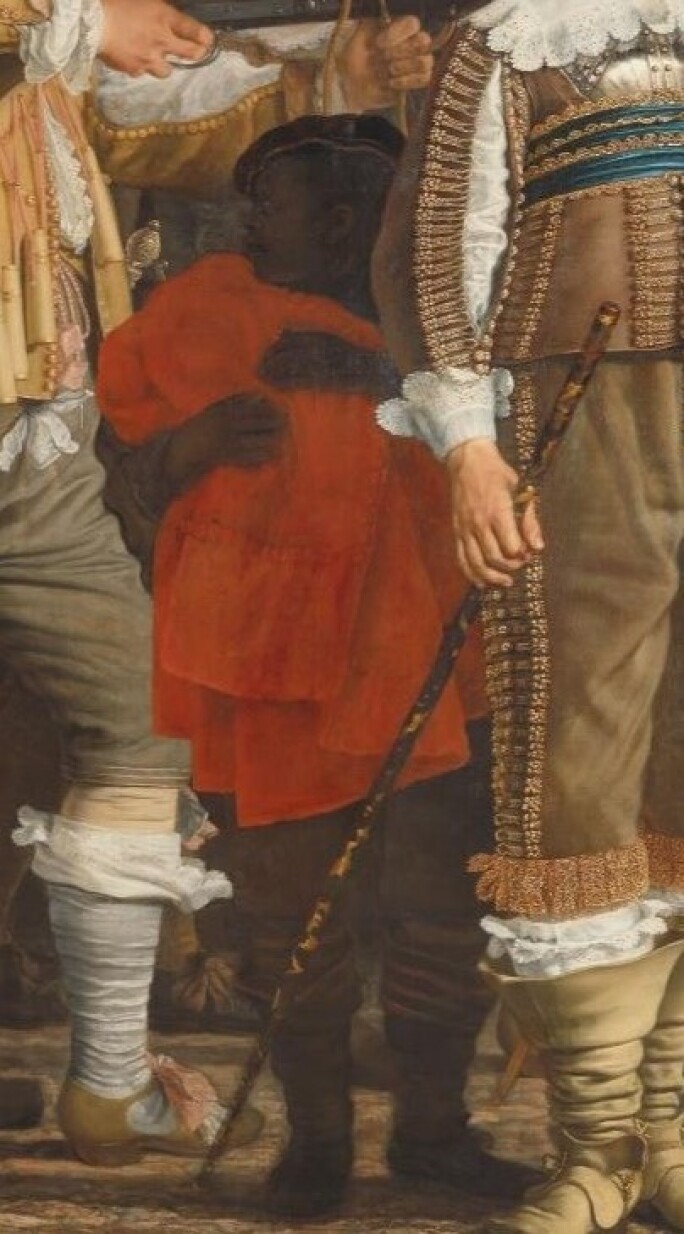A
n arresting and singular composition, Bartholomaus Maton’s painting stands at the crossroads of martial iconography and portraiture. Executed with technical finesse, the work presents a resplendently dressed man of African descent in the guise of a standard bearer, dramatically emerging from an illusionistic oculus.1 Maton’s expert treatment of the work’s varied textures attests to his training under Gerrit Dou (see lot 27), a master of the fijnschilder technique.
Within companies of civic guards, standard bearers (also known as ensigns) occupied positions of singular importance: leading the charge into battle and tasked with holding their ground, they embodied the company’s valor and martial strength.2 Within Dutch militia portraiture, a genre that flourished during the seventeenth century when the Republic was in an almost constant state of war, the figure of the standard bearer featured prominently. Depictions of ensigns in full armor or fancy dress—a tradition originating in prints by Albrecht Dürer and Lucas van Leyden that became a codified form of patriotic imagery in Goltzius’ Great Standard Bearer3—conveyed civic virtue and patriotic fervor. As a member of the Leiden Schutterij militia company (whose ensign carried a green standard), Maton would have been intimately familiar with the traditions and pageantry surrounding these figures.


Yet Maton’s painting is unprecedented. Rather than portraying a native Dutch militiaman, he depicts a man of African descent as the central protagonist, a highly unusual choice for the time. While Black individuals occasionally appeared among groups of figures in civic guard paintings, such as the anonymous servant in Bartholomeus van der Helst’s Militia Company of District VIII in Amsterdam under the Command of Captain Roelof Bicker (figs. 1, 2), Maton places his subject in the center of the composition and thus confers upon him a sense of autonomy and authority.
Although the painting resists easy classification, its lifelike specificity suggests it is a portrait, as does the man’s presence in another of Maton’s works, in which, accompanied by a parrot, he smokes a pipe (fig. 3).4 Yet the theatricality of the man’s costume in both paintings aligns these images with the genre of the tronie—a character study often imbued with references to non-European or historical figures. Both Dou and Rembrandt explored this genre, frequently dressing their subjects in attire (then) indicative of some Western European perceptions of Near- and Middle-Eastern dress. In Maton’s composition, the man wears a scarlet coat with gold braid that is crossed by a red sash, a white scarf over a gleaming gorget, and a gem and pearl decorated turban crowned with stiff plumes—an ensemble that blends aspects of Eastern and Western military costume into a richly imaginative hybrid.

Right: The Present Work.
The man’s identity remains unknown.5 However, if the work is a portrait, the depiction itself provides salient clues. The sitter’s role as an ensign indicates he was a citizen (a requirement for participation in Dutch militia companies) and almost certainly a member of the burgherlijk elite. Alternatively, Jean-Michel Massing has suggested that Maton painted this work during his time in Stockholm, where he relocated in 1679.6 If so, the painting becomes all the more enigmatic. In Sweden—where there were fewer individuals of African descent than in the Netherlands, owing to the active Dutch participation in the trans-Atlantic slave trade—this portrayal would have resonated in particularly complex ways. More than a testament to Maton’s aesthetic ambitions, the painting reflects the complex shifting boundaries of identity, representation, and visual authority in seventeenth-century Europe.
1 Maton used this trompe l’œil device on several occasions. See, for example, Man Smoking a Pipe and Holding a Pike (Staatliches Museum Schwerin, inv. no. G 133); Astronomer (Saint Petersburg, State Hermitage Museum, inv. no. ГЭ-1074); and Allegory (formerly private collection, Stuttgart; see W. Bernt, The Netherlandish Painters of the Seventeenth Century, London 1969, vol. II, p. 742, reproduced).
2 Due to the enormous risk associated with the position, standard bearers received three times the pay of an ordinary soldier and had to remain bachelors. Hale 1999.
3 The engraving’s two-line inscription underscores the standard bearer’s unique role: “Signifer ingentes animos, et corda ministro, / Me stat stante phalanx, me fugiente fugit.” (“I, the standard bearer ensure steadfastness of mind and of heart; as long as I stand, the line holds, if I flee, it flees also.”)
4 Previously with Daphne Alazraki Fine Art, New York. See https://rkd.nl/imageslite/149477.
5 On the difficulty of identifying African and Afro-Dutch sitters, see Zwart in Rembrandts tijd, exhibition catalogue, E. Runia, S. Archangel, and E. Kolfin (eds.), Amsterdam 2020.
6 Massing 2011, p. 251.